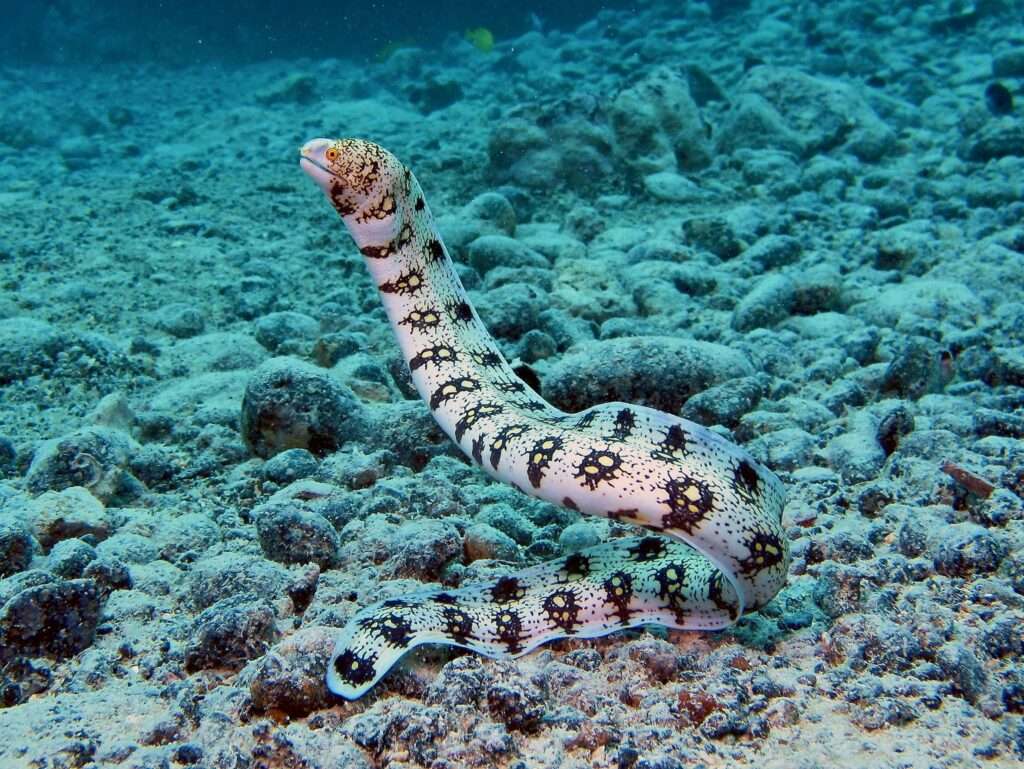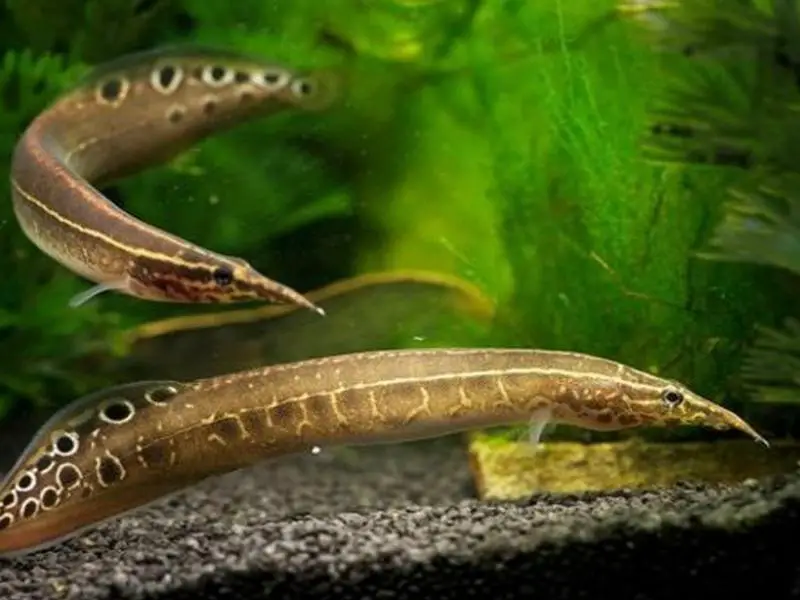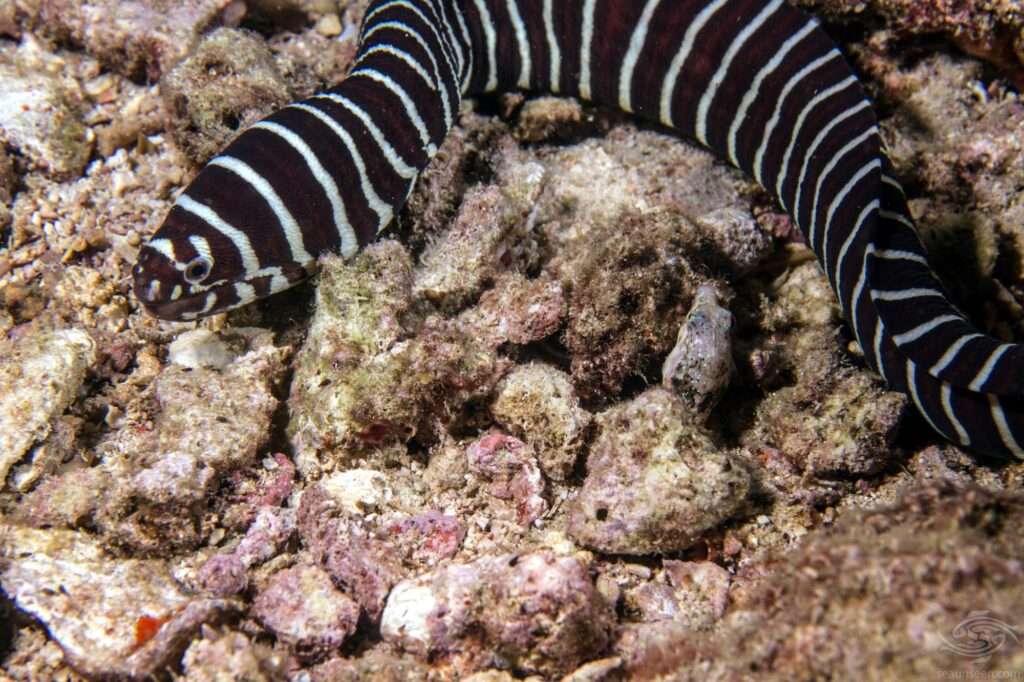
The Banded Snake Eel, also known as the Harlequin Snake Eel, is about the width of your thumb and is long and slender. Naturally, juveniles are smaller than adults. They have a uniform banding of off white and brown tones. They mimic the hue of the Banded Sea Snake (Laticauda columbrina), which is brown with narrower white to off-white bands, in locations where it is found. They are primarily white with thinner brown bars near Africa. They don’t have as keen of a head or nose as certain snake eel species. The head and face are unusual from many snake eels since they are not pointed; in fact, other “Myrichthys’ ‘ (apart from M. maculosus) seem to have pointier heads.
Along their jaws, they have two rows of blunt teeth. The Banded Snake Eel’s tail tip shares the same color as the rest of its body. They are described as a fish for experts but, at 34.6″ (88 cm) in length, are more suitable for intermediate aquarists. There have been statements made concerning Myrichthys genus snake eels that, while true for other snake eels, are not true for them. Feed only thawed silversides, scallops, shrimp, or fish flesh sourced from seawater. Due to their weak vision, banded snake eels hunt by scent and utilise their noses to locate prey. Even then, their aim is subpar, and they only emerge when dead fish or shrimp are thrown into the water at feeding time.
Habitat
Boddaert published the first account of the Banded Snake Eel in 1781. Broadnose Worm Eel, Harlequin Snake Eel, Banded Snake Eel, and Ringed Snake Eel are some of their common names. These names accurately reflect their pattern.
The Indo-Pacific region, stretching from the Red Sea to Delagoa Bay and then eastward from Mozambique, Africa, to the Society Islands and French Polynesia, is home to the Banded Snake Eel. They hunt during the day on seagrass meadows and small sandy flats. They function as janitors by consuming dead worms, fish, and crustaceans. They are found in depths of 3.3 to 81 feet (1 to 25 m). They have an edge over other carrion eaters in that they can fit through tiny cracks in the reef and use their extraordinary sense of smell to locate dead animals.
Traits
Both the Harlequin Snake Eel and the Spotted Snake Eel (M. maculosus) appear to differ slightly from other members of this species. These eels have blunt mouths and heads rather than pointed ones like the Sharptail Snake Eel (M. breviceps), which fits with their diet of dead fish and shrimp. They are not required to immediately delve into the sand in search of prey. The Banded Snake Eel is long and slender with uniformly spaced brown and whitish bands. Where the Banded Sea Snake is common, it is believed that they have a distinct color, brown with thinner white stripes, and that “variant” of Banded Snake Eel appears to have a much sharper nose. White with narrower black lines and uniform spacing with sporadic dark patches on the white bars are further color variations.
Keeping as Pet

Food Habits
Carnivores include striped snake eels. They use their noses to bump into things and find food because they have weak eyesight. Place a partially buried, thawed-out silverside that is smaller in girth than their mouth when you initially get them. Since the Banded Snake Eel will travel there in search of food when hungry, it is preferable to find a little cupped area of live rock that you can put the food into (ideally where a water pump won’t blow the food away).
When they are small, feed them every day, and when they are grown, feed them every two to three days. Snake eels are less likely to overeat than big eels. When they are filled, they plunge headfirst back into the sand. Once they are eating, give them a variety of little portions of scallop, shrimp, and fish flesh from saltwater sources. According to my observations, each snake eel has a particular feeding preference, although the majority prefer krill and silversides because they are both easy to spot and stinky. Large bits that their flinty teeth can’t break up may cause them to give up.
Fish Face Difficulty to Keeping in Aquarium
The Banded Snake Eel is quite hardy if given the right, “dead” meals. They merely require a tank with 2 to 3 inches of sand and tranquil fish on a reef or a fish-only aquarium. When they are swimming around, it usually indicates that they are either hungry or that an aggressive tank mate has been harassing them. Create sand-filled areas between the rocks for your snake eel to burrow through. Create arches and stack rocks so that you may add the right quantity of rock while still giving your Banded Snake Eel a spot to burrow. Verify that rocks, not sand, are resting on the bottom of the tank.
They don’t dig frequently and only dig burrows to conceal themselves. They are good once they are buried, like Nassarius Snails. The only substate that ought to be used is sand. In a saltwater tank, gravel or small round rocks cannot maintain a high pH, and crushed coral will lacerate the fish’s skin. Adults need a tank that is 24″ deep and at least 4 feet long; juveniles can live in a 55 gallon tank. Very large tanks above 90 gallons are not required because they do come out and swim, but only when they are hungry.
Large eels also fit this description. A 24″ tank’s depth merely serves to stop them from pushing on the substrate while leaning on the lid. The tank needs to be weighted down if it is shallower. Snake eels can squeeze through tiny gaps while being weaker than full-sized eels. The tank needs to be 150 gallons or more if you’re trying to keep a couple or a group. If you have had success with several snake eels, kindly remark below. Keep them in a reef environment, preferably with calm fish.
Table





